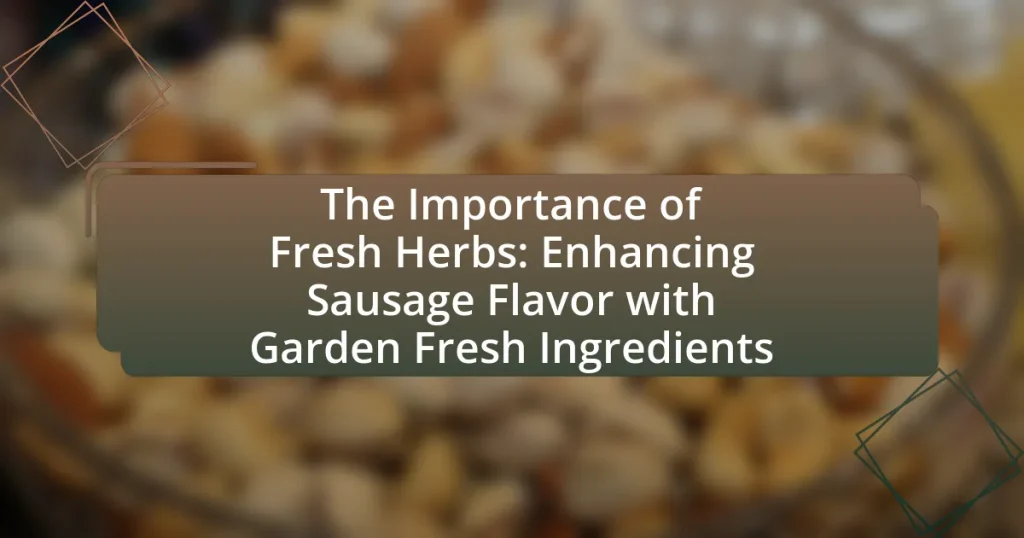The article focuses on the significance of fresh herbs in enhancing the flavor of sausage dishes. It highlights how fresh herbs, such as parsley, thyme, and basil, contribute vibrant flavors, aromas, and nutritional benefits, making them essential in cooking. The article discusses the chemical compounds in fresh herbs that enhance flavor, compares fresh and dried herbs, and emphasizes the importance of fresh herbs in sausage making. Additionally, it provides practical tips for incorporating fresh herbs into sausage recipes, including preparation methods and best practices for growing and harvesting herbs to maintain their flavor.

What is the significance of fresh herbs in cooking?
Fresh herbs are significant in cooking because they enhance flavor, aroma, and nutritional value of dishes. Their vibrant flavors can elevate the taste profile of various ingredients, particularly in sausage dishes, where herbs like parsley, thyme, and basil complement and balance rich flavors. Studies show that fresh herbs contain essential oils and antioxidants, contributing to health benefits such as anti-inflammatory properties and improved digestion. For example, a study published in the Journal of Agricultural and Food Chemistry highlights that fresh basil has high levels of antioxidants, which can enhance overall dish quality while providing health benefits.
How do fresh herbs enhance the flavor of dishes?
Fresh herbs enhance the flavor of dishes by adding vibrant, aromatic compounds that elevate taste profiles. These herbs contain essential oils and volatile compounds that contribute unique flavors, such as the peppery notes of arugula or the citrusy brightness of basil. Studies have shown that fresh herbs can increase the overall sensory experience of food, making dishes more appealing and complex. For instance, a study published in the Journal of Food Science found that the addition of fresh herbs can significantly improve the flavor perception of meat dishes, including sausages, by providing contrasting and complementary tastes.
What chemical compounds in fresh herbs contribute to flavor enhancement?
Chemical compounds in fresh herbs that contribute to flavor enhancement include essential oils, phenolic compounds, and terpenes. Essential oils, such as those found in basil and oregano, contain compounds like eugenol and linalool, which provide aromatic qualities and enhance taste. Phenolic compounds, present in herbs like rosemary and thyme, contribute to bitterness and complexity, while terpenes, found in herbs such as cilantro and mint, add freshness and citrus notes. These compounds interact synergistically to create a rich flavor profile, making fresh herbs essential for enhancing the taste of dishes like sausage.
How do fresh herbs compare to dried herbs in flavor intensity?
Fresh herbs have a more intense flavor compared to dried herbs. This is primarily due to the higher concentration of essential oils and volatile compounds present in fresh herbs, which can diminish during the drying process. For example, basil, when fresh, contains about 0.5% to 1.5% essential oils, while dried basil typically has a significantly lower concentration, resulting in a less vibrant flavor profile. Studies have shown that fresh herbs can enhance the overall taste of dishes, particularly in recipes like sausage, where the freshness can complement and elevate the meat’s flavor.
Why are fresh herbs particularly important in sausage making?
Fresh herbs are particularly important in sausage making because they enhance flavor, aroma, and overall quality of the sausage. The inclusion of fresh herbs, such as parsley, thyme, or basil, introduces vibrant and complex flavors that dried herbs cannot replicate. Studies have shown that fresh herbs contain higher concentrations of essential oils and volatile compounds, which contribute to a more pronounced taste profile. For instance, a study published in the Journal of Food Science found that sausages made with fresh herbs exhibited significantly improved sensory attributes compared to those made with dried herbs. This demonstrates that fresh herbs are essential for achieving a superior flavor experience in sausage production.
What role do fresh herbs play in the overall taste profile of sausage?
Fresh herbs significantly enhance the overall taste profile of sausage by adding complexity, freshness, and aromatic qualities. The inclusion of herbs such as parsley, thyme, and basil introduces vibrant flavors that can balance the richness of the meat, creating a more nuanced and enjoyable eating experience. Studies have shown that fresh herbs contain essential oils and compounds that contribute to flavor depth, making the sausage more appealing to consumers. For example, the presence of rosemary can impart a savory note, while cilantro adds a bright, citrusy element, demonstrating how specific herbs can tailor the flavor profile to desired culinary outcomes.
How do fresh herbs affect the aroma of sausage?
Fresh herbs significantly enhance the aroma of sausage by introducing complex, aromatic compounds that complement the meat’s natural scents. The volatile oils found in herbs such as basil, thyme, and rosemary release fragrant notes during cooking, which can elevate the overall sensory experience of the sausage. Studies have shown that the addition of fresh herbs can increase the perception of freshness and quality in meat products, making them more appealing to consumers. For instance, research published in the Journal of Food Science indicates that herbs can contribute to a more desirable aroma profile, influencing consumer preferences and perceptions of flavor.

What types of fresh herbs are best for enhancing sausage flavor?
Fresh herbs that best enhance sausage flavor include parsley, sage, thyme, and rosemary. These herbs contribute distinct aromatic profiles that complement the savory taste of sausage. For instance, sage adds a warm, earthy flavor, while thyme provides a subtle, minty note. Parsley offers a fresh, bright contrast, and rosemary imparts a robust, pine-like essence. The use of these herbs is supported by culinary practices, where they are commonly paired with various types of sausage to elevate flavor complexity and enhance overall taste.
Which herbs are commonly used in sausage recipes?
Commonly used herbs in sausage recipes include sage, thyme, rosemary, and parsley. Sage is particularly favored for its strong flavor, often found in traditional pork sausages. Thyme adds a subtle earthiness, while rosemary contributes a fragrant aroma. Parsley is frequently used for its fresh taste and color enhancement. These herbs not only enhance the flavor profile of sausages but also have historical significance in various regional recipes, showcasing their importance in culinary traditions.
What unique flavors do basil and oregano bring to sausage?
Basil and oregano contribute distinct flavors to sausage, enhancing its overall taste profile. Basil imparts a sweet, slightly peppery flavor with hints of mint and anise, which adds freshness and complexity to the meat. Oregano, on the other hand, offers a robust, earthy flavor with a slight bitterness, providing depth and a savory quality that complements the richness of sausage. Together, these herbs create a balanced and aromatic blend that elevates the dish, making it more flavorful and appealing.
How does the use of parsley and thyme influence sausage taste?
The use of parsley and thyme significantly enhances the taste of sausage by adding freshness and complexity to its flavor profile. Parsley contributes a mild, slightly peppery taste that brightens the overall flavor, while thyme introduces earthy and aromatic notes that deepen the savory quality of the sausage. Together, these herbs balance the richness of the meat, making the sausage more palatable and flavorful. Studies have shown that incorporating fresh herbs like parsley and thyme can elevate the sensory experience of meat dishes, leading to a more enjoyable eating experience.
How can the choice of herbs impact the type of sausage being made?
The choice of herbs significantly impacts the flavor profile and character of the sausage being made. Different herbs contribute unique aromatic compounds and flavors that can enhance or define the overall taste of the sausage. For example, using rosemary imparts a robust, pine-like flavor, while thyme adds a subtle earthiness. Additionally, herbs such as basil and oregano can introduce Mediterranean notes, influencing the sausage’s culinary style. The specific combination of herbs can also affect the perceived freshness and complexity of the sausage, making it more appealing to consumers. Studies have shown that the inclusion of fresh herbs can elevate the sensory qualities of meat products, leading to higher consumer preference and satisfaction.
What herbs are best suited for spicy sausage varieties?
The best herbs suited for spicy sausage varieties include oregano, thyme, and parsley. Oregano adds a robust flavor that complements the heat of spices, while thyme provides earthy notes that enhance the overall taste profile. Parsley, on the other hand, offers a fresh contrast that balances the spiciness. These herbs are commonly used in various spicy sausage recipes, such as Italian and chorizo sausages, where their flavors meld with the meat and spices to create a well-rounded dish.
How do herbs complement different meat types in sausage?
Herbs enhance the flavor profile of different meat types in sausage by providing complementary tastes and aromas that elevate the overall sensory experience. For instance, robust meats like pork benefit from herbs such as sage and thyme, which add depth and balance to the richness. In contrast, lighter meats like chicken are often paired with herbs like basil and parsley, which impart freshness and brightness. Additionally, beef sausages are frequently complemented by herbs such as rosemary and oregano, which enhance the savory notes inherent in the meat. The strategic use of herbs not only enriches the flavor but also contributes to the aromatic complexity of the sausage, making it more appealing to consumers.

How can fresh herbs be effectively incorporated into sausage recipes?
Fresh herbs can be effectively incorporated into sausage recipes by finely chopping them and mixing them directly into the meat mixture before stuffing or forming the sausages. This method ensures that the essential oils and flavors of the herbs are evenly distributed throughout the sausage, enhancing the overall taste. For example, using herbs like parsley, thyme, or basil can add freshness and complexity to the flavor profile, as supported by culinary practices that emphasize the use of fresh ingredients to elevate dishes.
What are the best methods for preparing fresh herbs for sausage?
The best methods for preparing fresh herbs for sausage include chopping, bruising, and infusing. Chopping herbs finely releases their essential oils, enhancing flavor integration within the sausage mixture. Bruising herbs, such as basil or mint, by gently crushing them with a knife or mortar and pestle, allows for a more intense flavor release. Infusing herbs in fat, like olive oil or butter, before mixing them into the sausage can also deepen the flavor profile. These methods are supported by culinary practices that emphasize the importance of maximizing herb potency to elevate the overall taste of sausage dishes.
Should herbs be chopped, minced, or left whole for optimal flavor?
Chopping or mincing herbs is generally recommended for optimal flavor. When herbs are cut, their cell walls break down, releasing essential oils and compounds that enhance flavor. For instance, studies show that finely chopped herbs can provide a more intense flavor profile compared to whole leaves, as the increased surface area allows for better infusion into dishes. Therefore, for maximum flavor impact in recipes, especially in enhancing sausage dishes, herbs should be chopped or minced.
How does the timing of herb addition affect flavor in sausage?
The timing of herb addition significantly affects the flavor profile of sausage. Adding herbs early in the cooking process allows their essential oils to infuse into the meat, resulting in a more robust and integrated flavor. Conversely, adding herbs towards the end of cooking preserves their fresh, vibrant characteristics, leading to a brighter and more aromatic taste. Research indicates that heat can diminish the potency of certain volatile compounds in herbs, which is why the timing of their addition is crucial for achieving the desired flavor outcome in sausage.
What are some tips for growing and harvesting fresh herbs for sausage making?
To grow and harvest fresh herbs for sausage making, select herbs like parsley, thyme, and sage that enhance flavor. Plant these herbs in well-drained soil with adequate sunlight, ideally 6-8 hours per day, to promote healthy growth. Regularly water the herbs, ensuring the soil remains moist but not waterlogged, as this encourages robust flavor development. Harvest herbs by cutting stems just above a leaf node, which stimulates further growth and ensures a continuous supply. Research indicates that fresh herbs can significantly enhance the flavor profile of sausage, making them a valuable addition to the recipe.
How can home gardeners ensure a steady supply of fresh herbs?
Home gardeners can ensure a steady supply of fresh herbs by implementing a staggered planting schedule and utilizing indoor growing techniques. Staggered planting involves sowing seeds or planting seedlings at regular intervals, which allows for continuous harvests throughout the growing season. For instance, planting basil every two weeks can provide a consistent supply. Additionally, growing herbs indoors under grow lights can extend the growing season and provide fresh herbs year-round, as many herbs thrive in controlled environments. Research indicates that indoor herb gardens can yield fresh produce regardless of outdoor conditions, making this method effective for maintaining a steady supply.
What are the best practices for harvesting herbs to maintain flavor?
To maintain flavor when harvesting herbs, it is essential to pick them in the morning after the dew has dried but before the sun is too hot. This timing ensures that the essential oils, which contribute to the herb’s flavor, are at their peak concentration. Additionally, using sharp scissors or pruning shears to cut the stems cleanly prevents damage to the plant, allowing it to continue growing and producing flavorful leaves. Harvesting only a portion of the plant, typically no more than one-third, encourages healthy regrowth and sustained flavor over time. These practices are supported by horticultural studies indicating that proper harvesting techniques significantly enhance the quality and longevity of herb flavor.
What practical tips can enhance the use of fresh herbs in sausage making?
To enhance the use of fresh herbs in sausage making, incorporate herbs at the right stage of the process, ideally during the mixing phase to allow their flavors to infuse thoroughly. Fresh herbs like parsley, thyme, and basil should be finely chopped to maximize their surface area, which increases flavor release. Additionally, using a variety of herbs can create a more complex flavor profile; for instance, combining savory herbs with aromatic ones can elevate the overall taste. It is also beneficial to balance the quantity of herbs with the meat to avoid overpowering the sausage; a general guideline is to use about 1 to 2 tablespoons of fresh herbs per pound of meat. Finally, consider the freshness of the herbs, as using them within a few days of harvest ensures optimal flavor and aroma.
